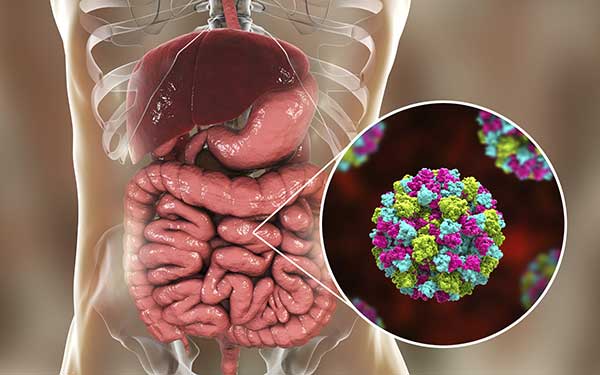Norovirus Infection Symptoms: Norovirus, often referred to as the winter vomiting bug, is a highly contagious virus known for causing rapid-onset outbreaks of gastroenteritis.
This article provides an in-depth look at the symptoms and causes of norovirus infections, equipping readers with essential information to manage and prevent this common illness.
What is Norovirus?
Norovirus is a highly contagious virus commonly known as the stomach flu or winter vomiting bug. It is the leading cause of gastroenteritis, an inflammation of the stomach and intestines, which manifests in symptoms such as vomiting, diarrhea, nausea, and stomach pain. Norovirus can affect people of all ages and spreads quickly in enclosed environments like hospitals, nursing homes, schools, and cruise ships. Transmission occurs through direct contact with an infected person, consuming contaminated food or water, or touching contaminated surfaces and then touching the mouth.
Statistics on Norovirus Infection Rates and Impact on Public Health
Norovirus is a significant public health concern due to its high infectivity and rapid spread. Here are some key statistics highlighting its impact:
- Global Incidence: The Centers for Disease Control and Prevention (CDC) estimates that norovirus causes about 19 to 21 million cases of acute gastroenteritis in the United States annually.
- Hospitalizations and Deaths: Norovirus results in approximately 1.8 million healthcare visits each year in the U.S. alone. Globally, it is responsible for nearly 200,000 deaths annually, mostly among young children and the elderly in developing countries.
- Economic Impact: The economic burden of norovirus is considerable, with costs running into billions annually. These costs arise from healthcare expenses and lost productivity due to illness.
- Outbreaks: Norovirus is notorious for causing outbreaks in community settings. According to the CDC, it is responsible for over half of all reported outbreaks of gastroenteritis.
However, the data highlight the substantial burden that norovirus places on public health systems worldwide, underlining the need for effective hygiene practices and better preventive measures to control its spread.
Symptoms of Norovirus Infection
Here, we delve into the primary and secondary symptoms of norovirus infection, its progression, and how these symptoms compare with other common gastrointestinal infections.
Primary Symptoms of Norovirus Infection
The onset of norovirus is typically sudden, and the primary symptoms are:
- Vomiting: Intense and frequent episodes, often occurring without warning, which are particularly common in children.
- Diarrhea: Watery and non-bloody diarrhea, which is more prevalent in adults.
- Stomach Pain: Cramping and general discomfort in the stomach area.
- Nausea: A persistent feeling of being sick, which often precedes vomiting.
These symptoms usually develop 12 to 48 hours after exposure to the virus and are the body’s immediate response to the infection.
Secondary Symptoms and Their Progression
As the infection progresses, secondary symptoms may appear, including:
- Fever: Mild to moderate in intensity, often accompanying other symptoms.
- Headache: Ranging from mild to severe, headaches can compound the discomfort caused by the infection.
- Body Aches: General muscle aches and pains are common, adding to the overall feeling of malaise.
- Dehydration: Especially in young children, the elderly, and people with compromised immune systems, dehydration can occur due to fluid loss from vomiting and diarrhea.
These secondary symptoms usually follow the primary symptoms and can exacerbate the feeling of illness, typically lasting 1 to 3 days.
Comparison with Other Common Gastrointestinal Infections
Norovirus symptoms can be similar to those of other gastrointestinal infections like rotavirus, food poisoning, and bacterial gastroenteritis. However, there are subtle differences:
- Speed of Onset: Norovirus symptoms appear more suddenly compared to those of bacterial gastroenteritis, which can take longer to manifest.
- Nature of Diarrhea: Unlike the bloody diarrhea that can accompany bacterial infections like E. coli or Shigella, norovirus-induced diarrhea is watery and non-bloody.
- Contagiousness: Norovirus is more contagious and can lead to widespread outbreaks more quickly than most bacterial causes of gastroenteritis.
However, understanding these differences is crucial for proper diagnosis and treatment, as the management of norovirus often primarily involves symptom relief and preventing dehydration, rather than the antibiotics or other treatments used for bacterial infections.
Causes of Norovirus Infection
Understanding the causes, transmission methods, risk factors, and common sources of outbreaks can help in preventing the spread of this infection.
How Norovirus is Transmitted and Spread Among People
- Person-to-Person Contact: Norovirus is predominantly spread through direct contact with an infected person. This can occur by sharing utensils, touching the same surfaces, or caring for someone who is ill.
- Contaminated Food and Water: Consuming food or water that has been contaminated with norovirus is a common route of transmission. Foods can be contaminated at the source, such as oysters harvested from contaminated water, or through handling by an infected person.
- Airborne Particles: Although less common, norovirus can also spread through airborne particles, which are released when an infected person vomits or flushes a toilet. These particles can then settle on surfaces or be ingested if they reach the mouth.
Risk Factors for Contracting Norovirus
- Close Living Quarters: People living in close quarters, such as dormitories, nursing homes, and cruise ships, are at higher risk of contracting norovirus due to the ease of virus spread in enclosed spaces.
- Weak Immune Systems: Individuals with weakened immune systems, including young children, the elderly, and those with certain medical conditions, are more susceptible to norovirus infections.
- Lack of Proper Hygiene: Inadequate handwashing and general poor hygiene can increase the risk of spreading norovirus, especially in communal settings or during food preparation.
Common Sources of Norovirus Outbreaks
- Healthcare Facilities: Hospitals and nursing homes are frequent sites of norovirus outbreaks due to the high concentration of vulnerable individuals and close interactions.
- Educational Institutions: Schools and universities can experience outbreaks, especially in communal dining areas and dormitories where close contact and shared facilities enhance transmission risks.
- Cruise Ships and Hotels: The high number of people in a contained environment, combined with shared dining and recreational facilities, makes cruise ships and hotels hotspots for norovirus outbreaks.
- Restaurants and Catered Events: Food handling and preparation areas that do not adhere strictly to hygiene standards are common sources of norovirus outbreaks, as contaminated food can infect a large number of people at once.
However, good hygiene practices, such as regular handwashing and proper food handling, are key measures in controlling the spread of norovirus.
Diagnosing Norovirus Infection
Diagnosing norovirus can be crucial for managing outbreaks, especially in settings like hospitals, cruise ships, and schools. Here, we explore the methods used for diagnosing this infection and the challenges associated with symptom-based diagnosis.
Methods Used to Diagnose Norovirus
- Stool Test: The most common method for diagnosing norovirus is through testing stool samples. This can be done using a polymerase chain reaction (PCR) test, which detects the genetic material of the virus and is highly sensitive.
- Enzyme Immunoassays (EIA): These tests detect norovirus antigens in the stool. While EIA tests are less sensitive than PCR, they are faster and commonly used in clinical settings for quick results.
- Real-Time PCR: This method not only detects the presence of norovirus but also quantifies the viral load. It is particularly useful in outbreak investigations to determine the spread and severity of the infection.
- Electron Microscopy: Though not commonly used due to its high cost and the need for specialized equipment, electron microscopy can visualize the virus directly in stool samples.
- Immunoassay Testing Kits: These rapid testing kits can be used on-site for immediate detection of norovirus antigens in fecal matter, although they are generally less accurate than laboratory PCR tests.
Challenges in Diagnosing Norovirus Based on Symptoms Alone
- Similarity to Other Gastroenteritis Causes: Norovirus symptoms are similar to those caused by other infectious agents like rotavirus, bacterial infections, and food poisoning. This makes it difficult to diagnose based on symptoms alone.
- Variability of Symptoms: Symptoms can vary widely among individuals. Some may exhibit mild symptoms, while others have severe manifestations, leading to potential underestimation of the actual spread of the virus.
- Asymptomatic Carriers: Individuals can carry norovirus without showing symptoms, yet still spread the virus, complicating efforts to track and control outbreaks based on symptomatic cases alone.
- Lack of Specificity: Common symptoms like vomiting and diarrhea are not exclusive to norovirus, requiring definitive laboratory tests to confirm the diagnosis and avoid mismanagement of the condition.
However, the variability of symptoms and their similarity to other diseases highlight the importance of accurate diagnostic methods to effectively manage and control outbreaks of this highly infectious virus.
Preventing and Managing Norovirus Infection
Below, we explore hygiene practices to prevent infection, treatment options for symptomatic relief, and the latest in vaccine development and research.
Effective Hygiene Practices to Prevent Norovirus Infection
- Frequent Handwashing: Regularly wash hands with soap and water, especially after using the restroom and before eating or preparing food. Hand sanitizers can be used but are less effective than soap and water in eliminating norovirus particles.
- Careful Food Preparation: Wash fruits and vegetables thoroughly and cook seafood completely to prevent contamination. Norovirus is highly resistant and can survive in temperatures up to 60°C.
- Clean and Disinfect Surfaces: Use a chlorine bleach solution or other EPA-approved disinfectants to clean surfaces that may be contaminated with norovirus. This includes kitchen areas, bathrooms, and common touch points like door handles and light switches.
- Avoid Contaminated Water: Do not consume raw or undercooked shellfish or any products from potentially contaminated water sources. Boil water if you suspect contamination.
- Isolate Infected Individuals: Keep those showing symptoms of norovirus infection away from others, especially from those involved in preparing food, to minimize the risk of spread.
Treatment Options and Supportive Care for Managing Symptoms
- Stay Hydrated: Rehydration is key in managing norovirus, as the virus causes severe diarrhea and vomiting. Drink plenty of fluids such as water, broth, and oral rehydration solutions to replace lost electrolytes.
- Rest: Allow your body to recover by resting as much as possible. This helps your immune system fight off the infection more effectively.
- Medication for Symptom Relief: Over-the-counter anti-diarrheal medications and antiemetics can be used to alleviate symptoms of diarrhea and nausea, respectively. Always consult with a healthcare provider before starting any medication.
- Monitor for Dehydration: Watch for signs of dehydration, especially in vulnerable populations like young children and the elderly. Symptoms include dizziness, dry mouth, and decreased urine output.
Role of Vaccines and Current Research on Prevention Strategies
- Vaccine Development: Currently, there are no commercially available vaccines for norovirus, but several candidates are in various stages of development. Research focuses on creating a vaccine that can provide broad protection against multiple strains of the virus.
- Genetic Research: Scientists are studying the genetics of norovirus to understand how it evolves and spreads. This research is crucial for developing effective vaccines and other prevention strategies.
- Community Immunity Studies: Researchers are exploring how immunity to norovirus develops in different populations and settings. This information could help in designing effective community-based prevention programs.
However, understanding and implementing these strategies are vital in preventing the spread of norovirus and managing its symptoms effectively.
When to Seek Medical Help for Norovirus Infection
If you or someone you know is dealing with a norovirus infection, it’s crucial to recognize when medical assistance is needed. Norovirus is highly contagious and typically manifests with stomach pain, diarrhea, nausea, and vomiting. While most people recover without treatment, certain situations warrant a call to a healthcare provider.
Guidance on When to Consult Healthcare Providers
- Persistent Symptoms: If symptoms such as vomiting and diarrhea persist for more than three days, it’s important to consult a healthcare provider. Prolonged symptoms can lead to dehydration and other complications.
- Dehydration Signs: Look for symptoms of dehydration, which include a decrease in urination, a dry mouth and throat, and feeling dizzy when standing up. Young children and infants may exhibit crying with few or no tears and unusual sleepiness or fussiness.
- High-Risk Individuals: People who are in high-risk groups—including young children, the elderly, pregnant women, and those with weakened immune systems—should seek medical advice early. In these groups, norovirus can cause severe illness.
- Uncertain Symptoms: If you are unsure whether the symptoms are due to norovirus or another more serious condition, such as appendicitis or a blocked intestine, it’s important to get medical advice.
Signs of Complications That Require Immediate Medical Attention
- Severe Abdominal Pain: If you experience intense and persistent abdominal pain, it could indicate serious complications that require immediate medical intervention.
- Bloody Diarrhea: While diarrhea is a common symptom of norovirus, the presence of blood can be a sign of a more serious infection or condition and should be promptly addressed.
- High Fever: A high fever (over 101°F or 38°C) accompanying norovirus symptoms can indicate a bacterial infection or other serious conditions that need medical evaluation.
- Signs of Severe Dehydration: Severe dehydration is a medical emergency. Symptoms include lethargy, confusion, a rapid heartbeat, and fainting. Immediate medical care is crucial to prevent serious health consequences.
Recognizing the signs that require medical intervention can prevent complications from a norovirus infection, ensuring a quicker recovery and reducing the risk of severe outcomes. If in doubt, always opt to consult a healthcare professional to safeguard your health and well-being.
FAQs about Norovirus Infection Symptoms
What are the primary symptoms of a norovirus infection?
The most common symptoms of norovirus are intense stomach pain, nausea, vomiting, and diarrhea. Some people may also experience a low-grade fever, headaches, and body aches.
How quickly do symptoms appear after exposure to norovirus?
Symptoms typically develop within 12 to 48 hours after being exposed to the virus. This rapid onset makes norovirus highly contagious and quick to spread in groups.
Can norovirus symptoms be mistaken for other illnesses?
Yes, the symptoms of norovirus can be similar to those of other gastrointestinal disorders, such as food poisoning or the stomach flu. However, the sudden onset and severity of symptoms are characteristic indicators of norovirus.
How long do norovirus symptoms last?
Norovirus symptoms usually last for 1 to 3 days. Most people recover fully without treatment, although hydration is important as the virus can cause significant fluid loss.
Are there any long-term effects of norovirus?
For most people, there are no long-term effects from a norovirus infection. It is crucial to manage hydration during the illness to prevent complications from dehydration.
When should someone seek medical attention for norovirus symptoms?
Seek medical attention if you or someone you are caring for experiences severe dehydration symptoms, such as a decrease in urination, dry mouth and throat, or feeling dizzy when standing up. Medical care is also advised for high-risk groups including infants, the elderly, and those with compromised immune systems.
Conclusion
In summary, norovirus presents a range of symptoms, most notably sudden onset of vomiting and diarrhea, which can severely impact individuals of all ages. The primary causes of norovirus infection include contaminated food and water, direct contact with an infected person, and touching contaminated surfaces followed by touching the mouth. Such transmission ease highlights the critical need for rigorous hygiene practices.
Awareness and preparedness are your best defenses against norovirus outbreaks. Regular hand washing, proper handling and preparation of food, and immediate isolation of affected individuals can significantly reduce the spread of this highly contagious virus. By staying informed and vigilant, communities can better manage and quickly contain outbreaks, minimizing their impact on public health.
References
For further reading and to validate the information provided on Norovirus infection symptoms, consider exploring the following reputable sources:
- Centers for Disease Control and Prevention (CDC) – The CDC offers comprehensive guidelines and the latest updates on Norovirus, including symptoms, treatment options, and prevention strategies. Visit their official page on Norovirus at CDC Norovirus.
- World Health Organization (WHO) – WHO provides detailed insights into Norovirus, focusing on global statistics, research, and health advisories. Access their resources at WHO Norovirus.
- Mayo Clinic – A trusted resource for patient care and health information, Mayo Clinic’s website includes an informative section on Norovirus symptoms, causes, and when to seek medical attention. Explore it at Mayo Clinic Norovirus.
These sources are crucial for anyone seeking in-depth and reliable information on Norovirus infections, helping both healthcare professionals and the public to stay informed about this common and contagious virus.



